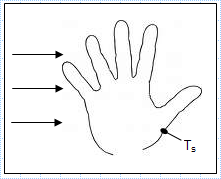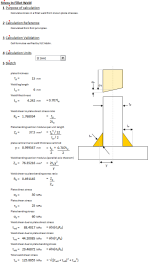Hand experiencing convection heat transfer with moving air and water.xls

Description
KNOWN: Hand experiencing convection heat transfer with moving air and water.
FIND: Determine which condition feels colder. Contrast these results with a heat loss of 30W/m2 under normal room conditions.
ASSUMPTIONS: 1) Temperature is uniform over the hand's surface
2) Convection coefficient is uniform over the hand
3) Negligible radiation exchange between hand and surroundings in the case of air flow
ANALYSIS: The hand will feel colder for the conditions which results in the larger heat loss. The Heat loss can be determined from Newton's law of cooling.
Calculation Reference
Fundamentals of Heat and Mass Transfer - Frank P. Incropera
To determine which condition feels colder, we can compare the heat loss in each case using Newton's Law of Cooling, which applies to convective heat transfer. The formula is:
Q = h * A * ΔT
Where: Q is the heat loss (in watts), h is the convective heat transfer coefficient (in watts per square meter-kelvin), A is the surface area of the hand (in square meters), ΔT is the temperature difference between the hand and the surrounding air or water (in kelvin).
Given that the heat loss under normal room conditions is 30 W/m², we can compare the heat loss in the two scenarios to determine which feels colder.
Let's assume:
- A hand surface area of 0.01 m² (for example purposes),
- The convective heat transfer coefficient (h) is the same for both air and water conditions, as specified in the assumptions.
For the air flow condition, if the temperature difference (ΔT) between the hand and the moving air is, for instance, 5°C (or 5 K), we can calculate the heat loss as follows:
Q_air = h * A * ΔT
For the water condition, if the temperature difference (ΔT) between the hand and the water is, for example, 2°C (or 2 K), we can calculate the heat loss as follows:
Q_water = h * A * ΔT
By comparing Q_air and Q_water, the condition with the larger heat loss (higher Q value) will feel colder.
It's important to note that the convective heat transfer coefficient (h) can vary depending on the flow rate, fluid properties, and surface conditions. Additionally, these calculations assume uniform temperature distribution over the hand's surface and neglect radiation exchange between the hand and the surroundings in the case of air flow. These assumptions might not reflect the real-world conditions accurately.
Calculation Preview
Full download access to any calculation is available to users with a paid or awarded subscription (XLC Pro).
Subscriptions are free to contributors to the site, alternatively they can be purchased.
Click here for information on subscriptions.


